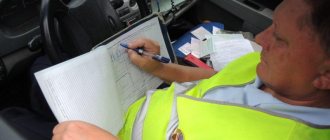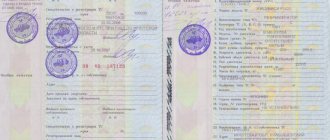- On railway crossings in traffic regulations;
- Deprivation of rights for 3 months or a fine of 1000 rubles;
- Deprivation of rights from 4 to 6 months or a fine of 5,000 rubles;
- Deprivation of rights for 1 year;
- Fine 1000 rubles;
- Features of qualifications when stopping at a crossing;
- The nuances of imposing a fine for driving through a prohibiting signal;
- Changes in fines for railway crossings in 2021;
About railway crossings in traffic rules
Rules for the passage of railway crossings contain the term “Railway crossing”:
“Railway crossing” is the intersection of a road and railway tracks at the same level.
The requirements are set out in section 15 of the Rules and consist of five points. All of them will be cited in this article. You can also look them up in the text of the Road Traffic Rules.
Traffic police fines are established by Article 12.10 of the Code of Administrative Offenses of the Russian Federation, which consists of three parts and part four of Article 12.15.
Deprivation of rights from 3 to 6 months or a fine of 1000 rubles
- 12.5. Parking is prohibited: in places where stopping is prohibited;
- …
- closer than 50 m from railway crossings.
12.10.1. Crossing a railway track outside of a railway crossing, entering a railway crossing when the barrier is closed or closing, or when there is a prohibiting signal from a traffic light or the person on duty at the crossing, as well as stopping or parking at a railway crossing - shall entail the imposition of an administrative fine in the amount of one thousand rubles or deprivation of the right to drive vehicles. for a period of three to six months.
Driving through a railway crossing on a red signal
In order, the requirements of the Rules that will be violated.
Crossing a railway track outside a railway crossing - clause 15.1.
15.1. Drivers of vehicles can cross railway tracks only at level crossings, giving way to a train (locomotive, handcar).
Entering a railway crossing when the barrier is closed or closing, or when there is a prohibiting signal from the traffic light or the crossing officer on duty - clause 15.3, requirements 1 - 3.
15.3. It is prohibited to enter the crossing: when the barrier is closed or beginning to close (regardless of the traffic light signal); when there is a prohibiting traffic light signal (regardless of the position and presence of the barrier); when there is a prohibitory signal from the person on duty at the crossing (the person on duty faces the driver with his chest or back with a baton, a red lantern or flag raised above his head, or with his arms extended to the side);
Stopping or parking at a railway crossing - clause 12.4, requirement 2.
12.4. Stopping is prohibited: ... at railway crossings, in tunnels, as well as on overpasses, bridges, overpasses (if there are less than three lanes for traffic in a given direction) and under them;
Clause 12.5 requirements 1 and 3.
For these violations, the driver will be deprived of his license for 3 to 6 months or a fine of 1,000 rubles. It is at the discretion of the inspector to impose a fine or take the case to court. By decision of the court, both deprivation of rights and imposition of a fine are possible. The fact that the case has been sent to court does not mean that the driver will necessarily be left without a driver's license.
Fines for violations of the rules for crossing railway tracks
Violation of the rules for crossing railway tracks is an administrative offense. In this case, according to Article 12.10 of the Code of Administrative Offenses of the Russian Federation (2018), vehicle drivers are punished with a fine or deprivation of their driver's license.
If a similar offense is committed again within a year, the driver’s license will be confiscated for 12 months.
For running a red light
In accordance with the Code of Administrative Offenses (Article 12.10), a fine is imposed for driving through a red light at a railway crossing. When committing this offense, the driver is fined 1000 rubles. or is punished by deprivation of rights (from 3 to 6 months). Such sanctions are also provided if the car passed while the barrier was closed or lowered (regardless of the light signal).
It is not allowed to cross railway tracks if, in the absence of a traffic light, the crossing officer shows prohibiting signals or there is an approaching train in sight. Movement through the tracks is prohibited if there is a traffic jam behind the crossing point, which can lead to a forced stop on the rails or in the immediate vicinity of the tracks.
If these rules are not followed, the driver will face a fine (RUB 1,000) or confiscation of his license for 3–6 months for driving through a railway crossing with a red light prohibiting it.
Penalties for overtaking, passing and stopping at a crossing
To prevent accidents, drivers are prohibited from performing certain actions when crossing railway tracks.
Prohibited maneuvers:
- Overtaking. This maneuver cannot be performed at the crossing itself or closer than 100 m before it. In case of this action, the driver who entered the oncoming lane for the purpose of overtaking is fined 5,000 rubles. or deprived of rights for 4–6 months. Warning signs are installed 100 m before the crossing to inform car owners about the presence of railway tracks.
- Detour. It is a violation to pass vehicles while entering the oncoming lane. It is strictly forbidden to drive through the entire traffic flow in front of the crossing and to wedge between cars directly in front of a barrier or traffic light. In this case, traffic police officers issue a fine of 5,000 rubles. or the driver is deprived of his license for 4–6 months.
- Stopping and parking. These actions create an emergency situation and can lead to casualties. For this reason, this offense is punishable by a fine of RUB 1,000. or deprivation of rights for 3–6 months. You cannot disembark passengers at the crossing and stop for a long time closer than 50 m from the railway tracks, after a warning sign.
To prevent a forced stop of a vehicle directly on the rails, drivers are prohibited from crossing the railway track if there is a traffic congestion after the crossing.
Deprivation of rights from 4 to 6 months or a fine of 5,000 rubles
4. Driving, in violation of the Traffic Rules, onto a lane intended for oncoming traffic, or onto tram tracks in the opposite direction, except for the cases provided for in Part 3 of this article, shall entail the imposition of an administrative fine in the amount of five thousand rubles or deprivation of the right to drive vehicles for period from four to six months.
Overtaking at a railway crossing
Entering the oncoming lane when passing railway crossings is prohibited:
Clause 15.3 requirement 8.
In addition, it is prohibited to: drive around vehicles standing in front of the crossing into oncoming traffic;
Clause 11.4 requirement 3.
11.4. Overtaking is prohibited: ... at railway crossings and closer than 100 meters in front of them;
How to pay a fine with a discount
After making a decision to impose a fine for violating traffic rules at a railway crossing, drivers have the opportunity to reduce the assigned amount. To do this, payment must be made within 20 days after receiving the collection. In this case, the amount of the fine is reduced by 50%. It is worth remembering that when the amount of unpaid penalties reaches 10,000 rubles, the traffic police may decide to suspend the driver’s license.
What are the penalties for repeated speeding?
Fine 1000 rubles
2. Violation of the rules for passing through railway crossings, except for the cases provided for in Part 1 of this article, shall entail the imposition of an administrative fine in the amount of one thousand rubles.
Stopping at a railway crossing during a traffic jam
All not mentioned above do not provide for the deprivation of the right to drive for violations when passing a railway crossing. Let's quote section 15 of the Traffic Rules in full and delete the deprivation clauses from it.
15.1. Drivers of vehicles can cross railway tracks only at level crossings, giving way to a train (locomotive, handcar).
15.2. When approaching a railway crossing, the driver must follow the requirements of road signs, traffic lights, markings, the position of the barrier and the instructions of the crossing officer and make sure that there is no approaching train (locomotive, railcar).
15.3. It is prohibited to travel:
- when the barrier is closed or starting to close (regardless of the traffic light signal);
- when there is a prohibiting traffic light signal (regardless of the position and presence of the barrier);
- when there is a prohibitory signal from the person on duty at the crossing (the person on duty faces the driver with his chest or back with a baton, a red lantern or flag raised above his head, or with his arms extended to the side);
- if there is a traffic jam behind the crossing that will force the driver to stop at the crossing;
- if a train (locomotive, handcar) is approaching the crossing within sight.
In addition, it is prohibited:
- drive around vehicles standing in front of the crossing into oncoming traffic;
- open the barrier without permission;
- transport agricultural, road, construction and other machines and mechanisms through the crossing in a non-transport position;
- without the permission of the head of the railway track, the movement of low-speed vehicles whose speed is less than 8 km/h, as well as tractor drag sleds.
15.4. In cases where movement through the crossing is prohibited, the driver must stop at the stop line, sign 2.5 or traffic light; if there are none, no closer than 5 m from the barrier, and in the absence of the latter, no closer than 10 m to the nearest rail.
15.5. When forced to stop at a crossing, the driver must immediately unload people and take measures to clear the crossing. At the same time, the driver must:
- if possible, send two people along the tracks in both directions from the crossing 1000 m (if one, then in the direction of the worst visibility of the track), explaining to them the rules for giving a stop signal to the driver of an approaching train;
- stay near the vehicle and give general alarm signals;
- When a train appears, run towards it, giving a stop signal.
These are violations for which only a fine of 1000 rubles is provided.
The principle of operation of a semaphore at a crossing
All railway crossings are divided into 2 types:
- Having adjustment;
- Unregulated.
At crossings that are regulated, semaphores are always installed to signal that passage through the railway tracks is prohibited. Additionally, barriers may be installed and traffic controllers on duty may be present.
There are two types of traffic lights at crossings:
- Two horizontal red signals. If these signals flash in turn, then entering the railway tracks and further travel is prohibited. The absence of signals means permission to pass;
- Three signals: two horizontal red and one white, located above the red ones. With such a traffic light, passage is allowed if the white signal is on. Passage is prohibited when the red lights are switched on alternately.
Traffic signals are triggered automatically or by manual connection. If the traffic light is controlled manually, then its signals are switched on by the person on duty at the crossing after receiving a signal that a train is approaching.
When a traffic light operates in automatic mode, it works like this:
Dear reader! Didn't receive an answer to your question? Our expert lawyers work for you. It's absolutely free!
- Moscow ext 152
- St. Petersburg ext 152
- All regions ext 132 (Toll free)
- The prohibiting signal turns on immediately after the rolling stock closes a special relay, which is located on the rails at a distance of up to 1 kilometer before the crossing;
- After the train passes the railway crossing, the relay opens and movement through the crossing resumes.
If the automatic red light signal does not work, the crossing officer can activate it.
Features of qualification when stopping at a crossing
Those who were attentive noticed seemingly contradiction in imposing responsibility for stopping at a crossing.
Stopping is prohibited: at railway crossings...
Provides for the deprivation of rights, but the prohibition to stop in a traffic jam is not deleted from the quotation of the 15th section.
It is prohibited to drive to a crossing: if there is a traffic jam behind the crossing that will force the driver to stop at the crossing;
It is not difficult to guess in which direction such a “contradiction” will be interpreted by the inspector. He will write in the decree the deprivation part 1 of article 12.10. An untrained driver will agree to the violation.
Remember, stopping traffic in a traffic jam is not a stop . When you are issued such a decree, do not agree and demand that a protocol be drawn up.
For more information about stopping and stopping, see this material.
Reclassification of such a violation will not be difficult. If the inspector is told before compiling the material that his classification of the violation is incorrect, then he will most likely issue a fine corresponding to the violation, that is, only 1000 rubles without the alternative of deprivation.
The nuances of imposing a fine for driving through a prohibiting signal
On roads with heavy traffic of trains and vehicles, there is a chance of falling into a trap and getting a fine for driving through a crossing at a prohibitory signal. How it works?
As you know, there is no warning signal at the traffic light at the railway crossing. And in heavy traffic, the red light may turn on when your car has already crossed the visibility zone of the traffic light. Traffic lights work synchronously.
On the opposite side of the crossing, an accident patrol with photo recording is located and takes pictures of the car entering the crossing and the red signal from the oncoming direction. The camera angle is set in such a way that it is not visible whether there is a car before or after the traffic light. From which it is concluded that the passage was carried out in response to a prohibitory signal.
Photo recording at a railway crossing
with a narrow viewing angle can save you from falling into such a trap . Wide-angle recorders “see” much wider than the human eye









